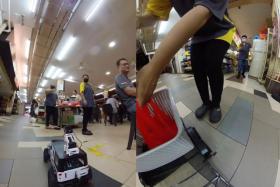Smarter living with 5G, but what to do about all the data?
Data insights will help companies make informed business decisions
For years, we've been hearing about the Internet of Things (IoT). Up till now, it has always been some distant reality featuring self-driving cars, drone-delivery, Smart TVs, AI-powered personal assistants and a fridge that stocks itself when the milk runs out.
Not anymore. With 5G networks on the horizon, it is only a matter of time before the IoT becomes a part of our everyday lives.
Unlike today's 4G networks, 5G mobile networks, expected to be up and running by 2020, will have high bandwidth, low latency and be virtually lag-free.
This means that the networks will be able to seamlessly support the flood of affordable, simple devices that will be brought online.
Asia might have adopted both 3G and 4G far later than the West, but with 5G, the third time just might be the charm.
According to an Ericsson Mobility Report, the Asia-Pacific (along with North America) is poised to lead 5G adoption, making smart homes an imminent reality.
In fact, flats in The Visionaire, a 632-unit executive condominium in Singapore, were marketed earlier this year as among the first smart homes in the city-state.
Global management consulting firm AT Kearney reports that Asia's smart home market is expected to reach US$115 billion (S$155 billion) in 2030, with growth driven by China and Japan and with highly-connected economies such as Singapore, South Korea and Taiwan also playing a key role.
3G gave us video streaming, while 4G perfected the sharing economy. As with every generation of network upgrades, new growth opportunities will present themselves. IoT devices will generate huge amounts of data, driving tremendous opportunities for data analytics across industries.
From a commercial standpoint, access to IoT data gives brands greater understanding of how consumers leverage technology, enabling them to provide consumers with exactly what they want, thus maximising profits and heightening brand loyalty.
Brands are also equipped to make business decisions to narrow gaps in the market and improve customer experiences.
CUSTOMER INSIGHTS
By tapping into vast swathes of data generated by IoT, telcos will gain access to invaluable customer insights, which often make up the basis of lucrative partnerships with other businesses.
Constant connectivity offers the chance for telcos to boost their revenue streams through machine-to-machine communications, easy payment systems and networking for the IoT.
As such, it will enable them to extend their customer base to include utilities, industrial supply chains, smart homes and smart cities, among many others.
Retailers also stand to benefit as they can use the information to develop new service-oriented business models that will better serve both consumers and businesses alike.
Currently, customers are already able to receive highly specific mobile offers based on both their location and consumption habits. With the IoT transforming even more objects into customer touch points, the possibilities are endless - such as by solving supply chain constraints and improving inventory management.
In a landscape saturated with information, brands require data analytics to make sense of customer data and answer questions like how and why do customers consume apps, how is the total data market growing, and what are the opportunities for innovation with 5G?
Today, some brands are already working with market research agencies to evaluate consumer data accurately in order to identify and build a roadmap of innovative possibilities.
As we step into the world of 5G and IoT, we are bound to be exposed to data overload, which makes data analysis a more critical aspect for brands now than before.
By leveraging these extensive data insights, brands can make informed business decisions, benefiting their core audiences.
The writer is Technology Industry Group Leader, APAC, at GfK Asia. This article appeared in The Business Times yesterday.
Get The New Paper on your phone with the free TNP app. Download from the Apple App Store or Google Play Store now


